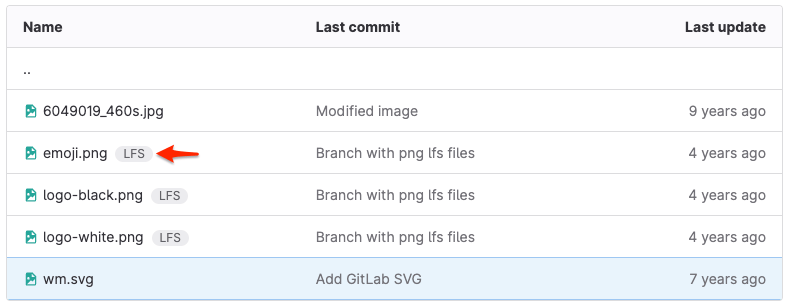Git Large File Storage (LFS)
Git Large File Storage (LFS) can manage large binary files efficiently in Git repositories. It addresses challenges, such as repository performance and capacity limits. For best performance, keep your repositories as small as possible. Git LFS creates pointers to the actual file, stored elsewhere.
For GitLab.com repository size limits, see account and limit settings.
Git LFS clients communicate with server over HTTPS, with HTTP Basic authentication. After the request is authorized, Git LFS client gets instructions on where to fetch or where to push the large file.
Configure your GitLab server for Git LFS
DETAILS: Tier: Free, Premium, Ultimate Offering: Self-managed, GitLab Dedicated
To install Git LFS on your self-managed GitLab server, see GitLab Git Large File Storage (LFS) Administration.
Enable Git LFS for a project
Prerequisites:
- You must have at least the Developer role in the project.
To do this:
- On the left sidebar, select Search or go to and find your project.
- Select Settings > General.
- Expand the Visibility, project features, permissions section.
- Turn on the Git Large File Storage (LFS) toggle.
- Select Save changes.
Install the Git LFS client locally
Install the Git LFS client appropriate for your operating system. GitLab requires version 1.0.1 or later of the Git LFS client.
After Git LFS is installed on the server and client, you can see the LFS badge next to the filename:
Known limitations
- Git LFS v1 original API is not supported, because it was deprecated early in LFS development.
- Even when Git communicates with the repository over SSH, Git LFS objects still go through HTTPS.
- Because Git LFS requests require HTTPS credentials, you should use a good Git credentials store.
- Git LFS always assumes HTTPS so if you have GitLab server on HTTP you must add the URL to Git configuration manually.
- Group wikis do not support Git LFS.
How LFS objects affect repository size
When you add an LFS object to a repository, GitLab:
- Creates an LFS object.
- Associates the LFS object with the repository.
- Queues a job to recalculate your project's statistics, including storage size and LFS object storage. Your LFS object storage is the sum of the size of all LFS objects associated with the repository.
When your repository is forked, the fork includes LFS objects from the upstream project. The LFS object storage for the fork, at first, is the same size as the storage used by the upstream project. If new LFS objects are added to the fork, the total object storage increases only for the fork.
If you create a merge request from the fork back to the upstream project, new LFS objects get associated with the upstream project.
Using Git LFS
Let's take a look at the workflow for checking large files into your Git repository with Git LFS. For example, if you want to upload a very large file and check it into your Git repository:
git clone git@gitlab.example.com:group/my-sample-project.git
cd my-sample-project
git lfs install # initialize the Git LFS project
git lfs track "*.iso" # select the file extensions that you want to treat as large filesThese commands create a .gitattributes file with the file types that you want to track.
In this case, Git LFS is now tracking *.iso files.
You can now use these commands to push a large *.iso file (and the new .gitattributes file) to
your repository:
cp ~/tmp/debian.iso ./ # copy a large file into the current directory
git add . # add the large file to the project
git commit -am "Add Debian iso and .gitattributes" # commit the file meta data
git push origin main # sync the git repo and large file to the GitLab serverMake sure you've committed .gitattributes to your repository. Otherwise Git
LFS doesn't work properly for those who clone it:
Cloning the repository works the same as before. Git automatically detects the
LFS-tracked files and clones them over HTTP. If you performed the git clone
command with a SSH URL, you have to enter your GitLab credentials for HTTP
authentication.
git clone git@gitlab.example.com:group/my-sample-project.gitIf you already cloned the repository and want the latest LFS objects that are on the remote repository:
git lfs fetch origin mainMake sure your files aren't listed in .gitignore, otherwise, they are ignored by Git
and are not pushed to the remote repository.
Migrate an existing repository to Git LFS
Read the documentation on how to migrate an existing Git repository with Git LFS.
Removing objects from LFS
To remove objects from LFS:
- Use
git filter-repoto remove the objects from the repository. - Delete the relevant LFS lines for the objects you have removed from your
.gitattributesfile and commit those changes.
LFS objects in project archives
- Introduced support for including Git LFS blobs inside project source downloads in GitLab 13.5 with a flag named
include_lfs_blobs_in_archive. Disabled by default.- Enabled on GitLab.com and self-managed in GitLab 13.6.
- Generally available in GitLab 14.0. Feature flag
include_lfs_blobs_in_archiveremoved.
Prior to GitLab 13.5, project source downloads would include Git LFS pointers instead of the actual objects. For example, LFS pointers look like the following:
version https://git-lfs.github.com/spec/v1
oid sha256:3ea5dd307f195f449f0e08234183b82e92c3d5f4cff11c2a6bb014f9e0de12aa
size 177735In GitLab version 13.5 and later, these pointers are converted to the uploaded LFS object.
Technical details about how this works can be found in the development documentation for LFS.
Related topics
- Use Git LFS to set up exclusive file locks.
- Blog post: Getting started with Git LFS
- Git LFS developer information
- GitLab Git Large File Storage (LFS) Administration for self-managed instances
- Troubleshooting Git LFS
